Pied Imperial Pigeons
The Pied Imperial Pigeons, Ducula biolor, are large white
pigeons with black wing tips and tail that grow to 40 – 46cm. The
gregarious fruit-eating birds spend winter in the rainforests of Papua
New Guinea and in September they migrate south to tropical coastal Australia
and offshore islands, such as Magnetic Island to breed over the summer
months. In April the birds depart again for Papua New Guinea. The birds
are easily seen tracing their call, a fairly loud deep ‘roo-ca-hoo’
or ‘up-ooo’ sound which is heard in the early morning or late
afternoon.
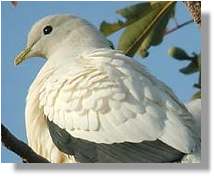 Pied Imperial Pigeon
Pied Imperial Pigeon
Click to enlarge |
Fruit Doves
Other doves and pigeons that have been seen in the Habitat Reserve include
the Rose-crowned fruit dove, Ptilinopus regina, and the Superb
Fruit-Dove, P. superbus.
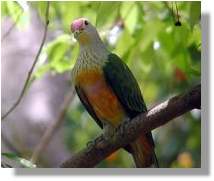 Rose-Crowned Fruit Dove
Rose-Crowned Fruit Dove
Click to enlarge |
Stone Curlews
The Bush Stone Curlew, Burhinus grallarius is a bird that
is commonly seen within the Nelly bay Habitat Reserve. The Bush Stone
Curlew grows to 55cm. Its dull brown and white patterns makes it well
camouflaged in the open woodland where it rests during the day and is
active at night looking for insects to feed on. Its mournful wailing and
whistling ‘wee-loo’ call can be distinctively heard at night.
The Bush Stone Curlew tactic is to freeze to a stand still to escape attention.
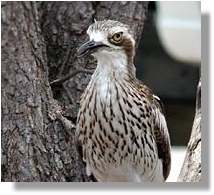 Stone Curlews
Stone Curlews
Click to enlarge |
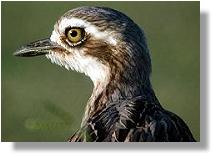 Stone Curlew
Stone Curlew
Click to enlarge
|
Orange – footed Scrubfowl
The Orange-footed Scrubfowl, Megapodius reinwardt, is the
smallest of the megapodes in Australia, however builds the largest incubation
mound, up to three metres high and seven metres wide, with sometimes several
pairs utilising the same mound. The elusive Orange-footed scrubfowl are
rare in Townsville although common Magnetic Island. The Scrubfowl is a
chicken sized, grey-brown bird that has a prominent crest on its head
with orange legs, hence the name. The birds may be seen scratching leaf
litter and will run quickly when disturbed, often flying to perch in the
trees. It has a loud raucous double crow and clucking noise that may be
heard at night. The scrubfowl will feast on an array of food including
berries, seeds, insects, grubs and roots.
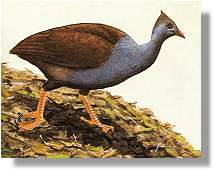 Orange - Footed Scrubfowl
Orange - Footed Scrubfowl
Click to enlarge |
|
